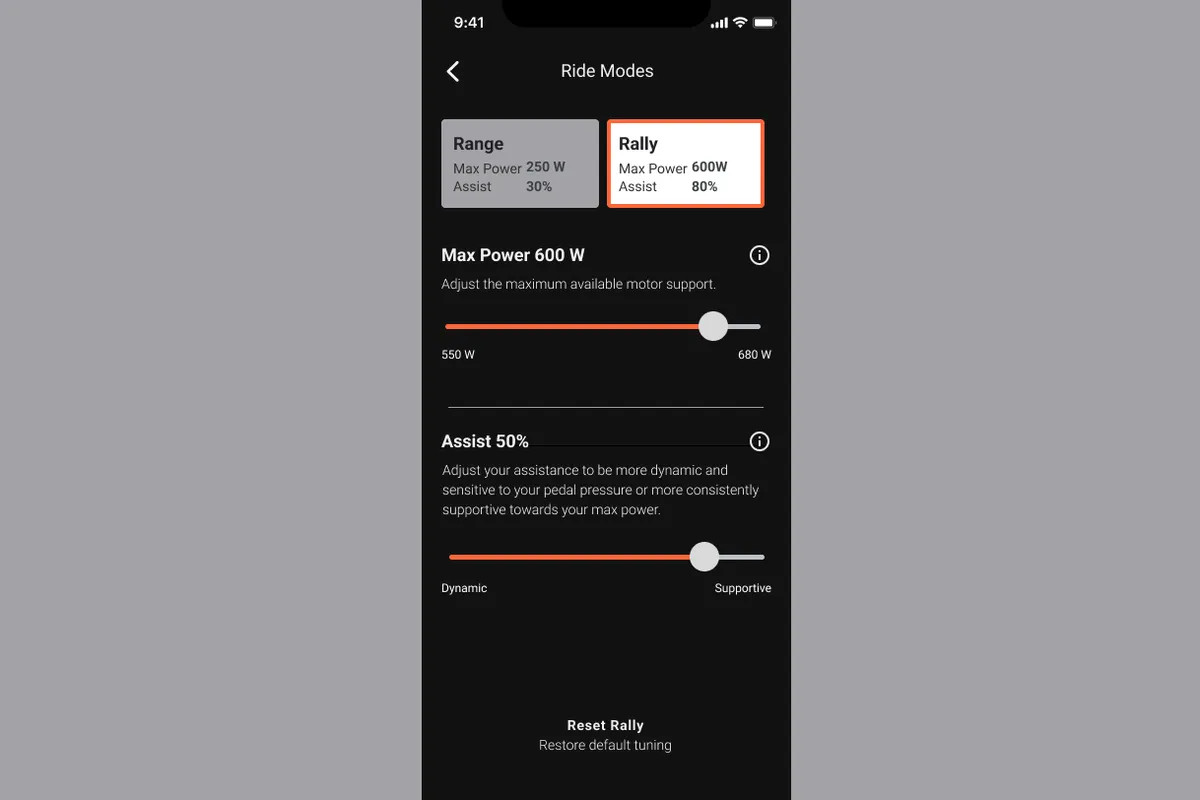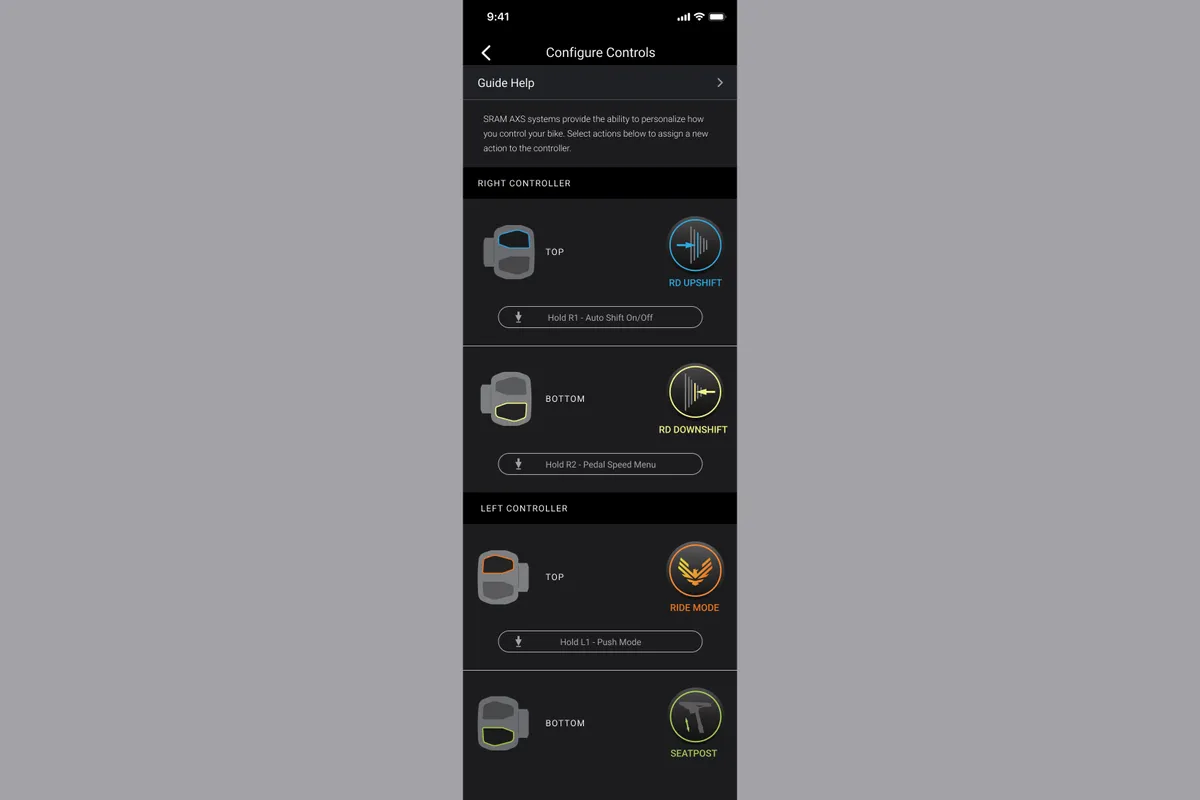SRAM’s all-new Eagle Powertrain ebike motor combines the proven on-power shifting performance of Eagle Transmission and AXS wireless technology, while adding automatic shifting to its “holistic E-MTB” recipe.
While the long-anticipated SRAM motor is exciting in its own right, Auto Shift, Coast Shift and wireless connectivity are its most tantalising features.
Using speed and cadence sensors, Auto Shift relies on Powertrain’s software to select the appropriate gear for your current pedalling rhythm, changing cogs regardless of how many watts you or the bike’s motor are outputting.
Coast Shift uses the motor to rotate the chainring and cassette independently of the cranks, enabling the system to change gear when you’re not pedalling. Using the speed sensor, it selects the most appropriate gear for your current speed.
This, SRAM says, is “designed to turn on uninterrupted flow”.

The made-by-Brose Powertrain drive unit boasts peak 90Nm torque and 680W power figures. It's compatible with two main battery sizes (630Wh and 720Wh) and a 250Wh range extender.
Integrating with SRAM’s other AXS components using the tech’s wireless protocol, Powertrain bikes are controlled by SRAM’s Pod Controllers, losing all the clumsy and untidy wiring from the front of the bike.
Powertrain can be synced with a RockShox Reverb AXS seatpost, RockShox’s Flight Attendant fork and shock, and Transmission gearing.
The system isn’t available as an aftermarket upgrade kit, but will be available on four bikes from Nukeproof, Propain, Transition and GasGas in the coming weeks.
You can read Alex Evans' review of SRAM Eagle Powertrain here.
Five things you need to know about SRAM’s Eagle Powertrain
- The made-by-Brose motor has 90Nm of peak torque and 680W of peak power
- Two battery capacities are available: 630Wh and 720Wh, plus a 250Wh range extender
- Auto Shift and Coast Shift change gears automatically as you ride, but changes can be overridden using the Pod Controller’s buttons
- Eagle Powertrain is designed to be used with Eagle Transmission, tapping into its impressive on-power shifting
- Powertrain, Transmission and AXS Reverbs are all controlled by two Pod Controllers – there are no extra buttons
SRAM Eagle Powertrain Auto Shift and Coast Shift
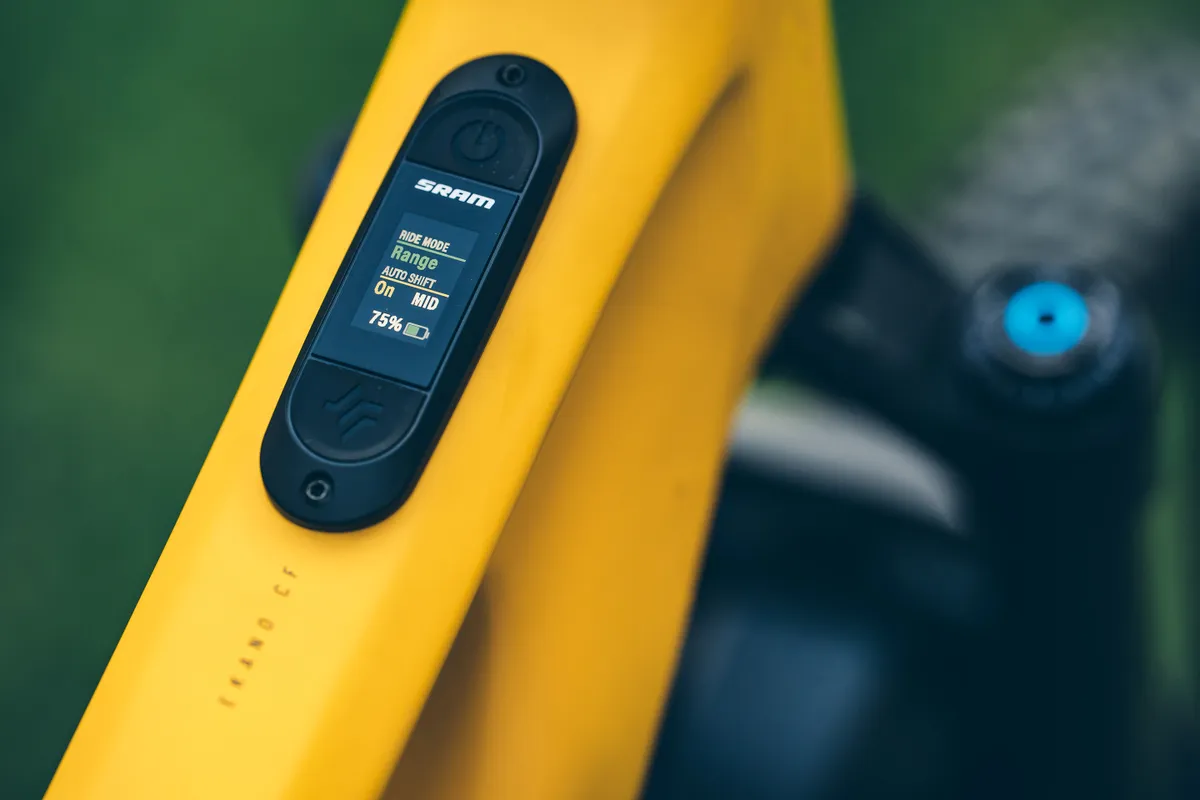
SRAM’s entry into the electric bike motors market is big news in itself, but the juiciest tech to come from the launch has to be Auto Shift and Coast Shift, unique to Powertrain.
When activated, these features take control of gear shifting from the rider.
Eagle Powertrain does the thinking for you, selecting the right gear for your pedalling cadence and bike speed, even when you’re accelerating or slowing down while freewheeling.
SRAM claims the Auto Shift “algorithm is like a bike’s sixth sense… [and helps riders] stay laser-focussed on their ride”.
To do this, the system shifts gears to keep rider cadence consistent. Pedal faster and it will shift to a harder gear; pedal slower and it shifts to an easier one.
Auto Shift’s cadence window can be adjusted to your taste.

Seven settings are available; if you like to grind slowly in a harder gear, setting the bias between -1 and -3 will hold a harder gear for longer, resulting in lower cadences (-3). If you prefer spinning your legs, dial in the bias between +1 and +3 for higher cadences. A ‘mid’ default setting is also available.
Coast Shift changes gear when you’re not pedalling, selecting the appropriate ratio for your speed.
Accelerate downhill while freewheeling and Coast Shift will change automatically into higher gears. Slow down and it does the opposite, shifting to easier gears as your speed decreases.
The motor rotates the chainring – and therefore drivetrain – as you freewheel, enabling the chain to move up or down the cassette.
To avoid engaging the freehub and driving the rear wheel, it rotates slower than the wheel is spinning, stopping it from interfering with rider inputs.
Any of Auto Shift or Coast Shift’s gear changes can be overridden by pressing the Pod Controller’s shift buttons.
Neither automatic shifting features precludes rider-defined shifts: “Auto Shift seamlessly accepts rider commands,” according to SRAM.
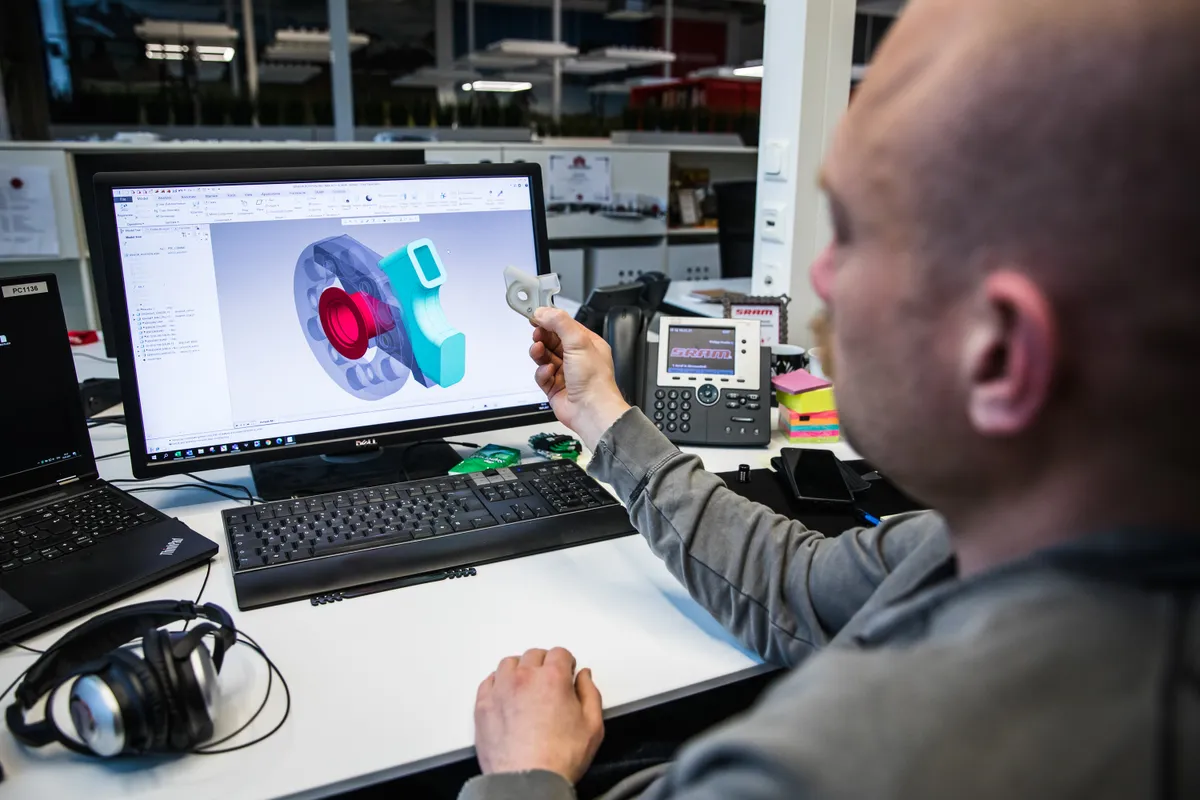
SRAM’s multi-magnet Speed Ring is different from almost all speed magnet designs on the market. By using multiple magnets – rather than just one – the data it supplies to the motor is richer and more instant because it doesn’t have to wait for a single magnet to pass the sensor once per revolution.
This is key to Auto and Coast Shift’s functionality.
But so is Eagle Transmission. Without it, SRAM claims Auto Shift and Coast Shift wouldn’t be possible. Tapping into the on-power shifting performance of Transmission means Powertrain can change gear when it needs to with no missed shifts.
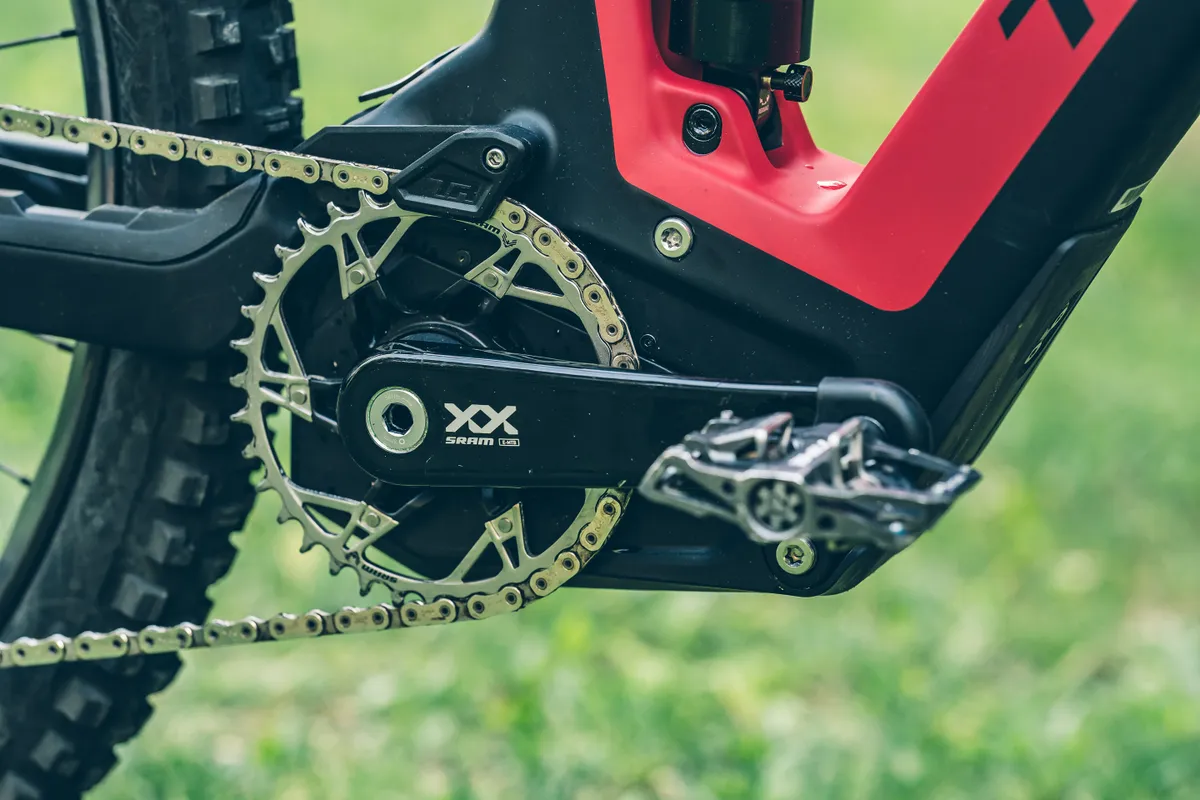
The derailleur is connected to and powered by the bike’s main battery via a wire. If the main bike battery runs flat while riding, SRAM says there’s enough power for at least two additional hours of shifting.
Only Transmission groupsets work with Auto and Coast Shift. Eagle AXS drivetrains can be powered by the motor’s battery, but the automatic gear-shifting features won’t be available.
The brand also states mechanical Eagle drivetrains can be used on Powertrain bikes, but along with the mechanical gear shifter, you’ll still need the right-hand Pod Controller.
It’s the same story with seatposts – for full integration, a Reverb AXS post is recommended. Mechanical dropper posts are compatible, but, like the gear shifter, you’ll need a dropper post actuator and left-hand Pod Controller to access all of the ebike’s functions.
The competition: Shimano EP8/601 and Deore XT Di2
Of course, SRAM isn’t the first groupset brand to launch an e-MTB motor.
Shimano entered the market in 2016 with its STEPS E8000 system, since superseded by its EP-series drive units, which have been specced on tens of thousands of bikes worldwide.
On paper, the latest EP801 and EP601 perform similarly to Powertrain, with up to 85Nm of torque and 600W of peak power.
The US outfit is also not the first to combine a motor with automatic shifting or gear changes while coasting.
Its Japanese rival introduced that for the 2023 model year, in the form of 11-speed Shimano Deore XT Di2 LinkGlide and 12-speed XT Di2 HyperGlide+, designed to work with the EP801/601 (in the case of Di2 HG+, with automatic shifting only available while freewheeling).
In fact, Shimano even coined the phrase Auto Shift for MTB use.
Where SRAM has got one up on its rival, though, is with the wireless connectivity of its kit. Not only does the lack of cables make for a much cleaner-looking bike, but it also makes it easier to fit and replace components.
The one downside is that each part (derailleur, Pod Controller, AXS post, Flight Attendant fork/shock) requires its own battery.
An integrated, customisable system

SRAM claims the electric mountain bike genre unites its trifecta of drivetrain technologies – AXS, Eagle Transmission and Powertrain – into one holistic, fully integrated system.
Rider flow, fun and focus on the trail are at the system’s core. AXS components – such as your Reverb seatpost, Flight Attendant fork and shock, and Transmission gearing, all connect to Powertrain.
All paired AXS components – including the Powertrain motor – are controlled by the AXS Pods; no extra bar-mounted ebike controllers are needed, reducing clutter and cables.
SRAM Eagle Powertrain controllers

Powertrain is only compatible with wireless AXS Pod Controllers; previous-generation AXS Controllers will not work.
The AXS Pod Controller’s four buttons can be assigned to perform shifting, seatpost adjustments and other functions in the AXS smartphone app according to your preferences. Only push mode cannot be reassigned – the left-hand top button must be used for “safety and legal requirements,” according to SRAM.
In their standard configuration, Powertrain’s controls are as follows:
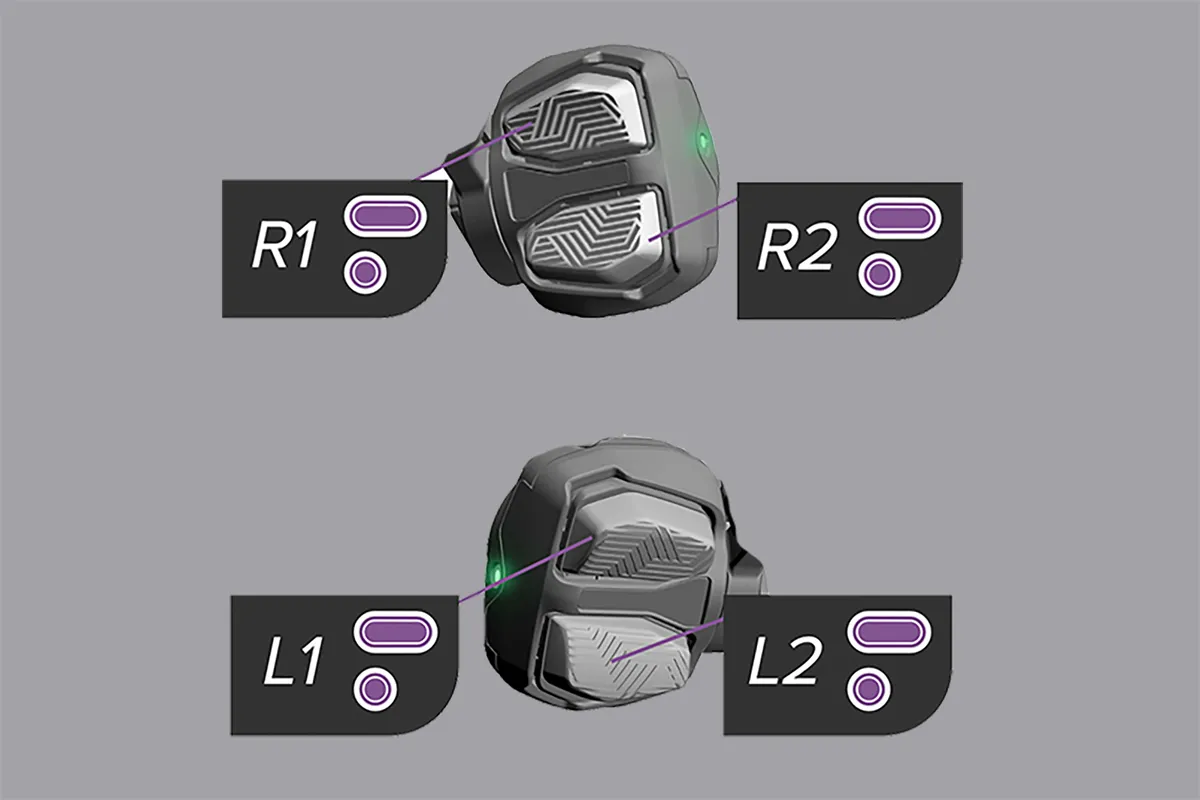
| Function | Button | Press type |
|---|---|---|
| Auto Shift on/off | Right 1 | Press and hold |
| Auto Shift adjustment | Right 2 | Press and hold |
| Shift to higher gear | Right 1 | Press |
| Shift to lower gear | Right 2 | Press |
| Push mode | Left 1 | Press and hold |
| Reverb AXS dropper | Left 2 | Press and hold |
| Mode selection Range/Rally | Left 1 | Press |
A long press of the left-hand lower button engages walk mode, while a long press of the right-hand bottom button adjusts the cadence rate for Automatic Shifting. A long press of the right-hand top button turns auto shift on and off.
SRAM Eagle Powertrain AXS Bridge Display
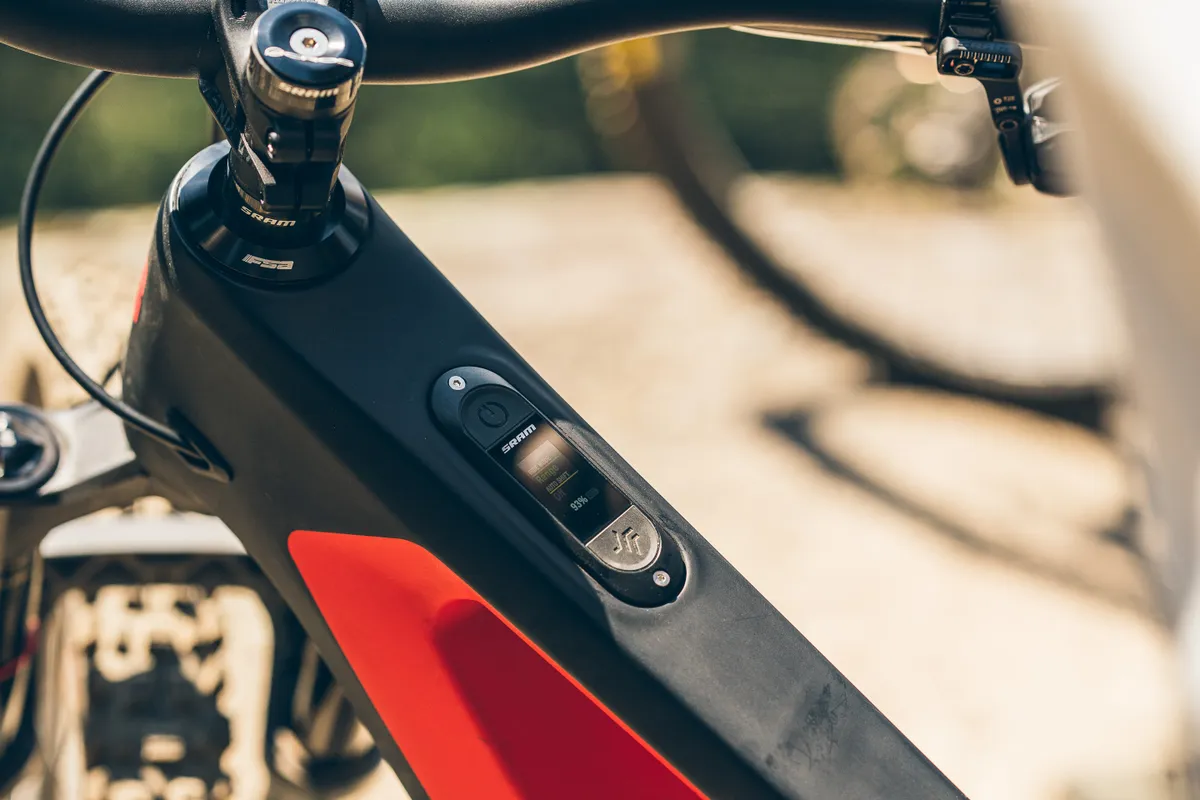
Doubling down on the clean aesthetic is the AXS Bridge Display that’s integrated into the bike’s top tube; there are no bar-mounted screens here.
It sits behind Gorilla Glass and shows only three bits of information; assistance mode, Auto Shift mode and remaining battery percentage.
But two physical buttons sit above and beneath the screen. One is used to turn the system on and off, and toggle the motor into service mode/motor support off. The other controls AXS pairing and changes assistance modes.
Like many ebike systems on the market, Powertrain can connect to GPS head units wirelessly.
Current gear, speed and assistance mode, battery charge, remaining range and rider power are all displayed, adding to the Bridge Display’s data.
SRAM AXS smartphone app
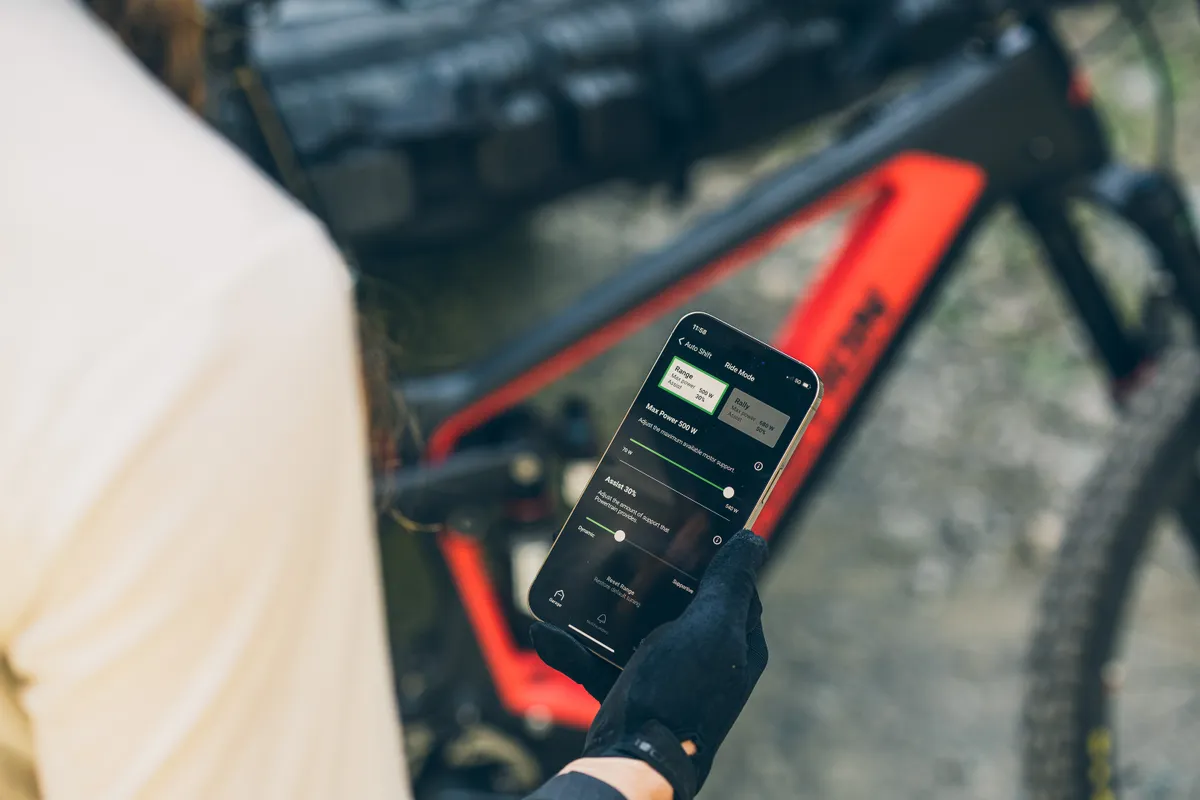
That leaves quite a bit of headroom for additional customisation and data to be displayed elsewhere.
Enter the ever-growing AXS smartphone app; once used solely for managing AXS drivetrain components, its functionality has expanded over the years.
Now, Powertrain extends that further. Within the app, you can adjust the assistance levels of the two modes (Range and Rally), tweak Auto Shift’s cadence setting, view battery life and health and the motor odometer, update the firmware and troubleshoot any issues.
SRAM Eagle Powertrain drive unit
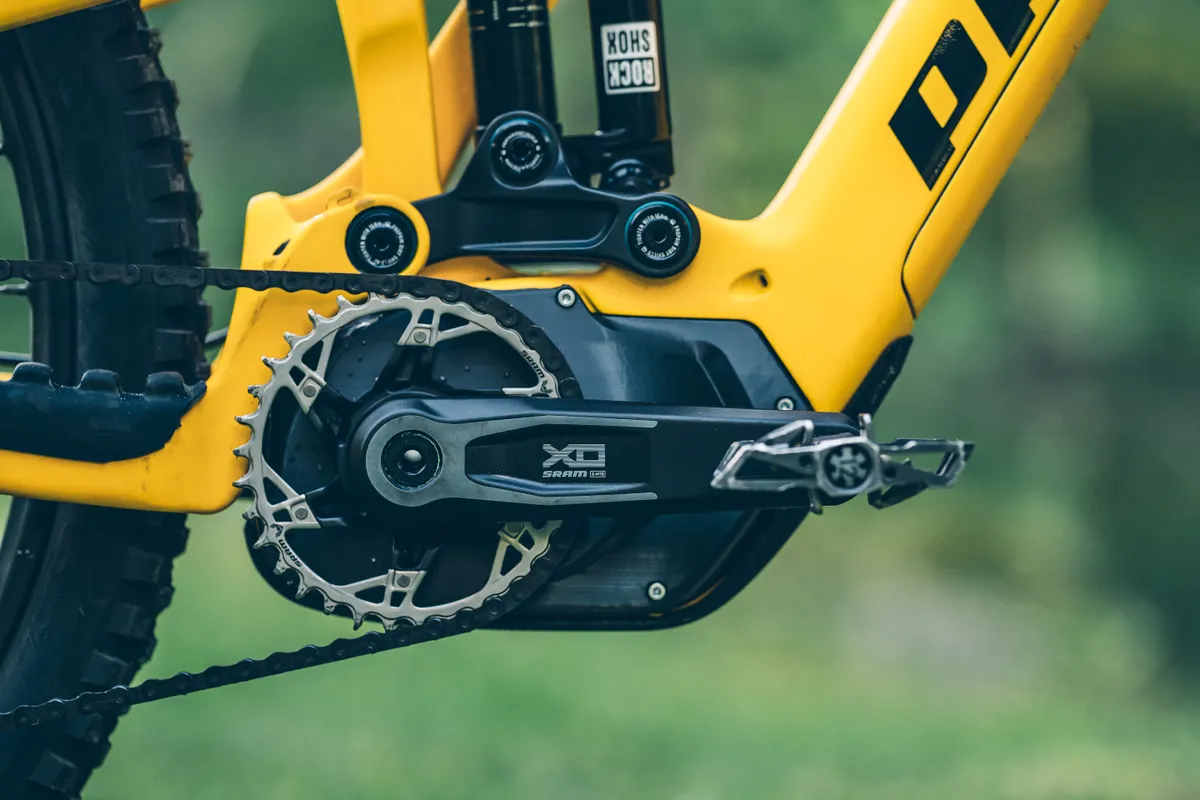
Made by Brose, SRAM’s Eagle Powertrain motor boasts peak torque and power figures of 90Nm and 680W respectively, and is claimed to weigh 2.9kg.
Brose isn’t new to the ebike market, however, and its motor is fitted to Specialized’s Turbo Levo and Turbo Kenevo. On these bikes, it delivers the same 90Nm torque figure as SRAM’s version, but slightly less peak power, at 565W.
SRAM has tuned the Brose unit for its needs, creating a “reimagined power delivery tune that replicates a far more natural pedaling experience”, but the motor’s design remains almost identical to the Specialized version, including the belt drive.
For the tech-savvy, lightbulbs might be turning on; the prospect of flashing SRAM’s firmware and software onto a Specialized unit – to access Auto Shift, Coast Shift and wireless AXS Pod Controller connectivity – could be ruminating in their minds.
In reality, this won’t be possible – Eagle Powertrain uses proprietary components, which can’t be adapted for third-party use.

Simplifying the ebike experience further, Powetrain has two riding modes: Range and Rally.
Range delivers less motor assistance and is designed for battery conservation or less punchy riding.
Rally taps into the motor’s full power, but uses the battery’s capacity quicker.
However, both modes can be fully customised, using sliders to tune power in the AXS app. If you want Range to offer as much power as Rally, that’s possible, and so is the inverse.
Unlike Shimano's Trail and Bosch's Tour+ and eMTB reactive modes, neither of Powertrain's modes are 'smart'. They don't adapt to rider inputs by increasing or decreasing assistance.
SRAM Eagle Powertrain battery capacities and sizes
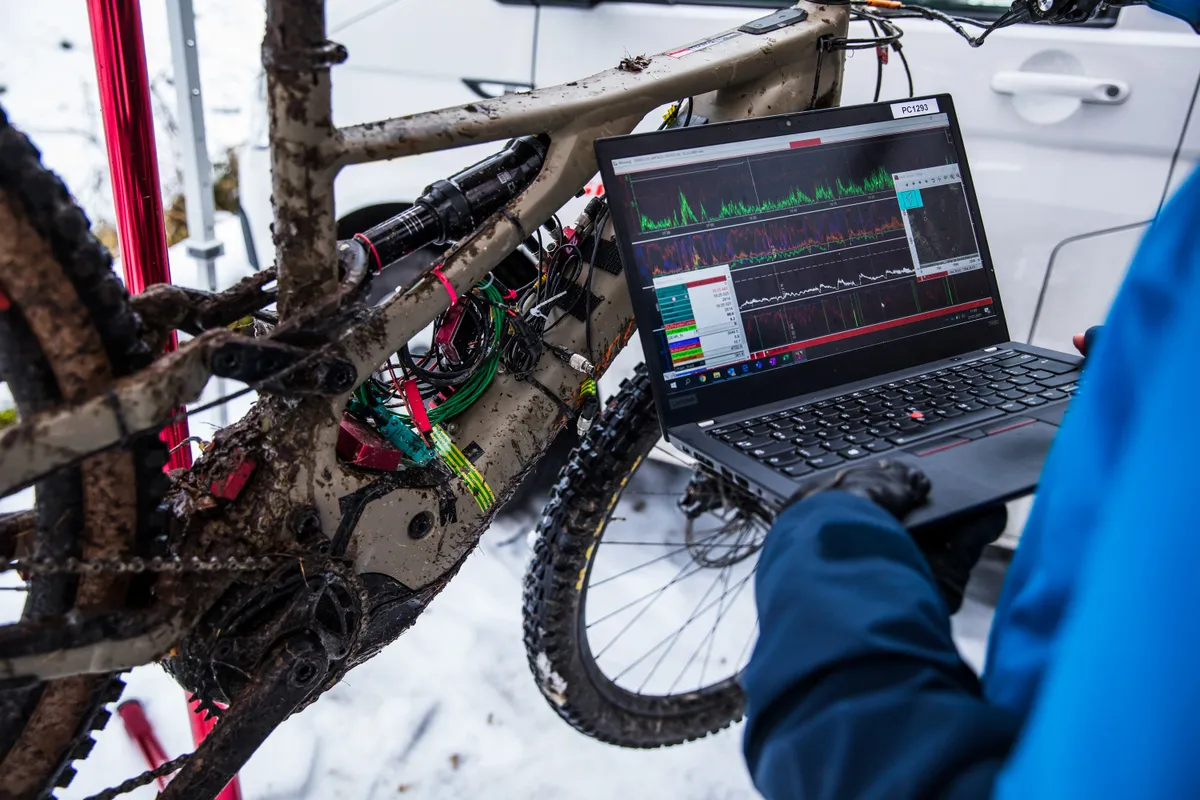
Two batteries will be available for Eagle Powertrain. A smaller 630Wh unit, that’s claimed to weigh 3kg, is designed for ‘open’ down tubes and clips into place.
The larger 720Wh battery (4.1kg, claimed) slides into the frame and is designed for ‘closed’ down tubes.
Both batteries are claimed to be easy to remove with a single Allen key and can be charged on or off the bike. However, some models of bike with Eagle Powertrain feature permanently mounted batteries.
A 250Wh range extender – that mounts to the bike’s bottle bosses – is also available. With the extender installed, the motor drains the main battery when the bike is in Rally mode, and the range extender in Range mode.
This, SRAM claims, uses “both batteries in the most efficient way”.
SRAM Eagle Powertrain bike availability
SRAM’s launch partners for Powertrain include Nukeproof, Transition, Propain and GasGas, with more brands due to launch bikes soon.

